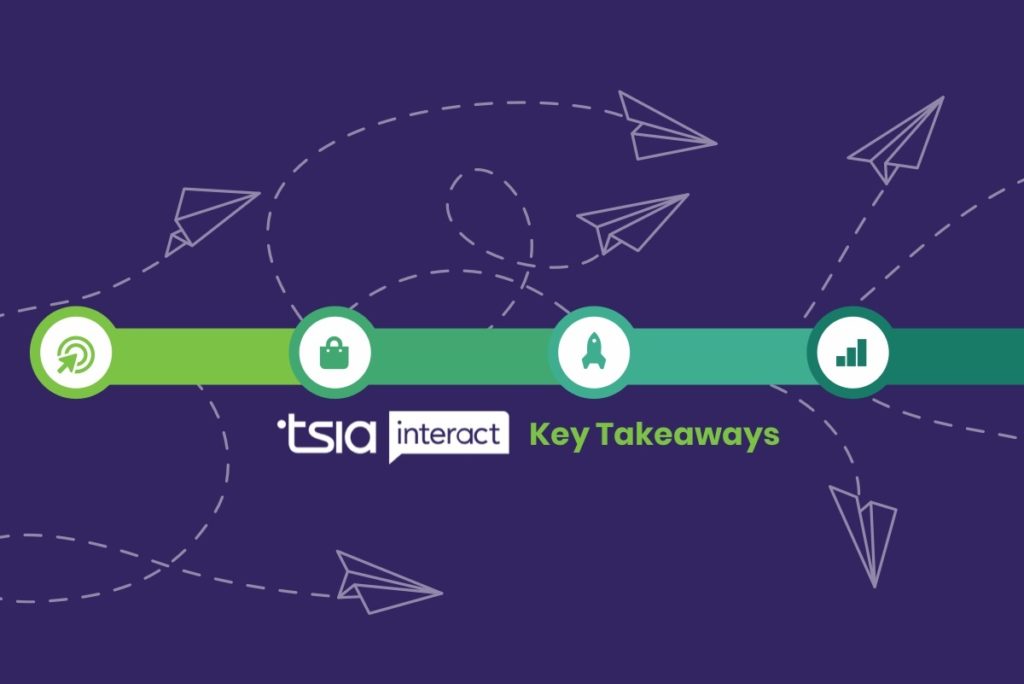We recently polled the Customer Success industry asking about the top challenges they are facing. The number one answer? Scale.
Over the years, we’ve found that most companies are very oriented around a high-touch customer engagement model. However, as the world has shifted (particularly last year during the pandemic), the modern customer journey has shifted as well and it now requires a different engagement model. Companies can no longer just rely on a one-to-one human model; they have to be able to bring technology and people together in order to deliver the optimal customer journey for each of their segments and to scale their business effectively.
In a recent webinar with the Technology & Services Industry Association (TSIA) Interact, Totango CCO and COO Jamie Bertasi spoke with Taylor Cunningham, Senior Global Director of Customer Marketing for Trustpilot, and Karla Russell, Senior Director of Customer Success and Client Adoption for Monster, about how companies can master scale by using digital-first customer journeys.
Here are some of the key takeaways from their discussion.
- Incorporate a mixture of both digital and human touch.
- Data is the lifeblood of a digital customer success program.
- The customer journey is not linear.
- Lean into automation.
- An iterative approach is essential.
Watch It Now: Mastering Scale with Digital Customer Journeys
Incorporate a Mixture of Both Digital and Human Touch
A ratio of one customer success manager (CSM) to 50 customers just doesn’t work for companies with hundreds or thousands of customers – and requesting more headcount is simply impractical. You can’t throw people at the problem, you have to learn to incorporate a mixture of both digital and human touch for each customer segment. A modern customer engagement model requires you to truly map out your customer journey, understand what it is you need to give each one of your customers at each stage of the journey, and use that combination of people and technology to optimize and scale.
Resource: Customer Journey Map Template
Data is the Lifeblood of a Digital Customer Success Program
Capturing and analyzing data is key to understanding your customers and learning what actions need to happen and when. You need data to understand what’s happening with your customers so you can use that insight to create and trigger the right actions needed to fix or intercept problems. For example, when Trustpilot deployed a tech-touch onboarding experience, they leveraged their product engagement data and marketing automation to shepherd users through the journey and identify key engagement moments. If a customer hadn’t followed through on a key engagement moment within a certain time frame, then that would trigger a follow-up action, such as an email reminder or app notification to get them back on the right track and seeing value from the product.
Resource: The Customer Data Platform Benefits You Should Know
The Customer Journey is Not Linear
No matter what stage of the journey your customer is in – whether it’s onboarding, adoption, expansion, retention, customer advocacy, escalation or risk – it’s important to remember that they are not going to flow through that stage and onto the next in a linear manner. Things will change, they will follow a different path than you think and you will have to pivot to meet their needs at that step. So, when mapping out your customer journey, it’s crucial that you leave room in each stage for customers to move around and for you to take appropriate action depending on what the customer is doing.
Resource: Customer Success Flywheel
Lean into Automation
Now is the time to start leaning into automation. However, don’t feel like you have to get digital touch automation in place for every segment all at once. Start by automating one task or workflow before tackling an entire journey stage. What you may realize is that once you’ve got all of your processes, engagement strategies, communications, and training in place for that one segment, then those same things could be applicable across every segment with little or no tweaks.
Resource: How to Use Customer Success Automation to Do More with Less
An Iterative Approach is Essential
Finally, when implementing a digital-first program and scaling your business, it’s important to make sure you’ve got an approach and technology that will allow you to very quickly iterate because you’re likely going to have to start out by making some assumptions. Those assumptions may be correct or they could be slightly off and you’ll have to iterate based on your data and results. Your team will be rapidly learning and deploying improvements at first, so iteration should be a key component of your strategy.
Resource: A Guide to Customer Journey Optimization
Go Digital Today
To learn more about how you can use digital customer journeys to help scale your business and hear the success stories of Trustpilot and Monster, check out the webinar here. And when you’re ready to get started on your digital-first journey and scaling your business, let us help! Sign up for Totango for free today at Totango.com/sign-up.

